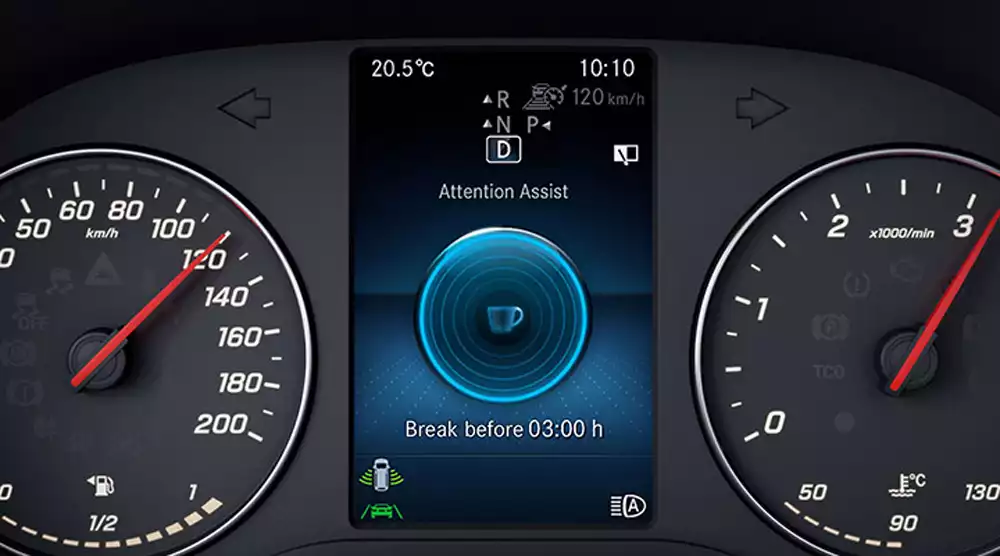Modern vehicles have come a long way since the first combustion engine. From turbo and supercharged engines to subtle aerodynamic upgrades, vehicle manufacturers are constantly coming up with revolutionary innovations to make faster and smarter cars.
But perhaps some of the most commendable changes in the average daily driver is the inclusion of advanced safety features. These features can vary, depending on the manufacturer. But for this particular article, we’ll be talking about Mercedes-Benz’s attention assist feature.
A Closer Look at the Mercedes-Benz Attention Assist Feature
The attention assist feature alerts the drivers that they’re showing signs of fatigue or drowsiness behind the wheel.

By showing a coffee cup sign on the dashboard, this feature encourages the driver to take a break. The driver will also hear an audible tone.
The attention assist feature debuted in some 2011 B-Class Mercedes-Benz models. Attention assist was standard equipment in all European countries.
The feature is in some C-Class, E-Class, and M-Class vehicles.
How Does Attention Assist Work?
Attention assist depends on a sensitive steering angle sensor to monitor how the driver is operating behind the wheel.
Normally, fatigued drivers tend to become inattentive, showing little steering input followed by exaggerated corrections once they regain attention.
This type of activity alerts the attention assist system that drowsy driving is taking place. This input is accompanied by other information like the time of day and duration of the journey.
The driver will notice a coffee cup icon on the dashboard once the attention assist feature activates.
If the driver doesn’t take a break after seeing the warning light and the drowsy steering activity continues, the attention assist message will reappear after 15 minutes.
Attention Assist Limitations
The attention assist feature is limited to alerting the driver, so it’s up to the driver how to respond.
Some drivers acknowledge that they’re getting drowse and take a break, while others ignore the message and continue driving.
The attention assist feature can also be inaccurate under extreme weather conditions like high-cross winds.

Driver Attention Alert
The attention assist feature goes by many names, depending on the manufacturer. For example, the feature is called “driver attention alert” in some Nissan and Mitsubishi models.
Driver attention alert generally works the same way as attention assist, relies on the same set of sensors, and has a coffee cup warning light.
It also uses statistical analysis of steering corrections to compare driving patterns, determining whether the driver is paying enough attention on the road.
Driver attention alert can identify false detections like lane changes, braking events, and poor road conditions.
If the driver attention alert malfunctions, the driver will see a message on the dashboard, and the system will stop operating.
Other Common Driver Assistance Features
In some parts of the world, drowsiness causes about 20% of serious road accidents. In 2021 alone, approximately 42,000 people die every year because of driving accidents, and most of them were attributed to human error.
Given these numbers, several car manufacturers have developed some of the most life-saving driver assistance features to date.
Let’s take a look at some of these features that were approved by the National Highway Traffic Safety Administration (NHTSA).
Lane Departure Warning
The lane departure warning sends a message to drivers to indicate they’re drifting out of the lane. Similar to attention assist, land departure can only alert the driver. It can’t steer the vehicle back into place.
Automatic Emergency Braking
This feature autonomously activates the brakes whenever it detects that a collision is about to take place. It uses radar, cameras, and LiDAR to identify life-threatening situations.
Automatic emergency braking debuted in luxury cars during the mid-2000s. In September 2021, most vehicles sold in the US have automatic emergency braking as standard equipment to comply with the NHTSA’s policy.
Adaptive Cruise Control
Adaptive cruise control automatically adjusts the vehicle’s speed to maintain a safe following distance.
Cameras, lasers, and radar equipment send information to the adaptive cruise control system to determine the vehicle’s distance from other cars.
Aside from maintaining a safe following distance, some adaptive cruise control systems also inform the driver of potential forward collisions.
Automatic Crash Notification
Automatic crash notification sends a signal to a telematics service operator as soon as the airbags deploy due to a collision.
Compared to other driver assistance features, automatic crash notification is far more advanced because it can transmit specific vehicle information. Some of these data include changes in vehicle speed, direction of impact, and whether seatbelts were in use during the crash.
In case operators can’t reach the driver, they can use the vehicle’s GPS to alert emergency services.
Blind Spot Intervention
The blind spot intervention system alerts the driver of other vehicles in adjacent lanes using radar sensors and a camera behind the windscreen.
Blindspot intervention uses a detection zone, which begins on the outside mirror and extends about 10 meters behind the rear bumper and 10 meters sideways.
Lane Keeping Assistance
Unlike the lane departure warning and attention assist features, lane keeping assistance can take control of the wheel. When activated in vehicles with electric power steering, lane keeping assist gently countersteers to return the vehicle to its lane.
Meanwhile, vehicles without electric power steering can still have lane keeping assistance, but it works a bit differently. These vehicles can use the electronic stability program to brake individual wheels.
Like other driver assistance features, drivers can also override lane keeping assistance to regain control over their vehicles. Lane keeping assist is smart enough to know whether or not the driver is intentionally switching lanes for it to intervene.
Leading Vehicle Departure Alert
Leading Vehicle Departure Alert (LVDA) displays a message on the cluster when the vehicle in front departs from a stop. Accompanied by an audible warning sound, it uses forward-facing sensors and cameras to monitor the vehicle in front of you.
This driver assistance feature is especially useful in stop-and-go traffic. It’s available on various Kia and Hyundai models, but you can turn it off if you prefer.
Why Does My Car Say Consider Taking a Break?
If you drive a vehicle from a different automaker, you might notice a different message flashing on your dashboard.
Most Kia models will alert the driver with a “Consider Taking a Break” notification when the sensors notice any signs of drowsiness. These include weaving through lanes and uncertainly shifting your hands on the wheel.
This Driver Attention Warning (DAW) feature has three modes, namely Off, Normal Sensitivity, and High Sensitivity. If you triggered this message while you’re driving fully alert, you might have to adjust the settings according to your preferences.
Any information provided on this Website is for informational purposes only and is not intended to replace consultation with a professional mechanic. The accuracy and timeliness of the information may change from the time of publication.




















